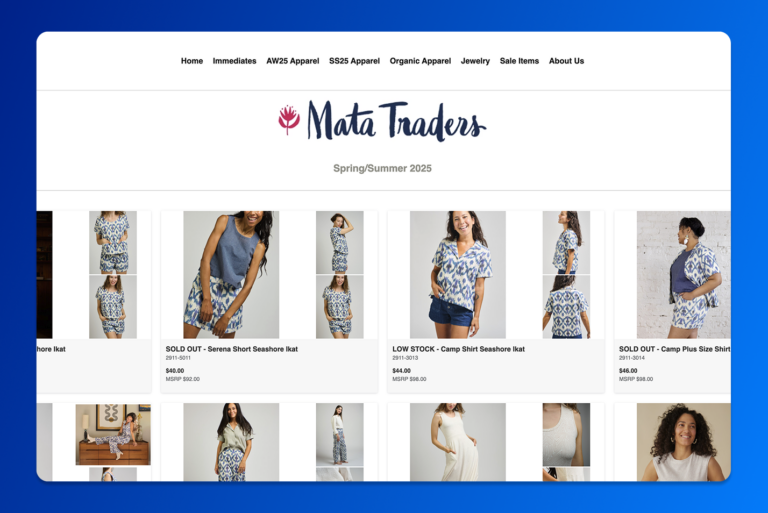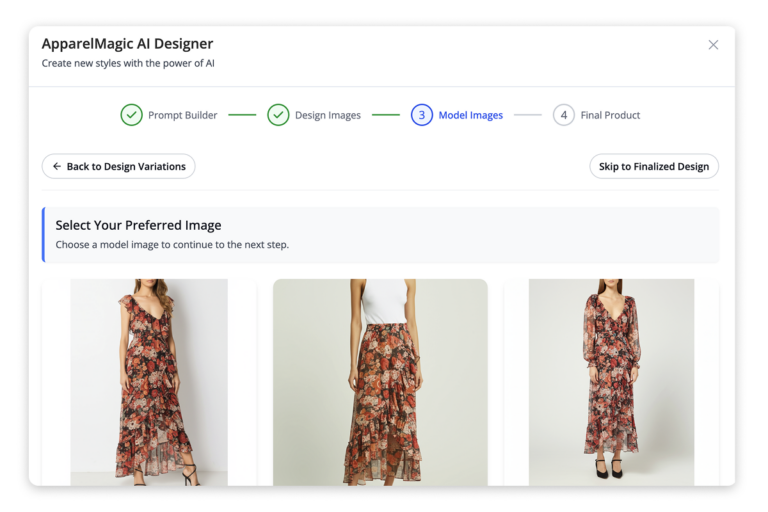Bracing for the ever-changing tides of fashion retail requires more than a keen eye for style—it demands a solid strategy. That’s where fashion planning steps in, serving as a lifeline for retailers aiming to merge trend forecasts with tangible profits.
Our blog post guides you through the essentials of fashion planning: perfecting your product mix, harnessing data for on-point inventory, and utilizing technology for smarter merchandising. Prepare to transform insight into action, and plan for a future dressed in success.
Mastering Assortment Planning in Fashion Retail
Navigating through merchandise planning is a complex task. The heart of this process lies in assortment planning, which empowers you to stock your store with diverse items that not only resonate with your customers but are also in sync with market demand and customer expectations. Ensuring you have the right mix on hand is essential for meeting one of a retailers’ greatest challenges: selecting the correct products in appropriate quantities that align with what your consumers want.
Fashion trends can be fleeting, causing an ever-shifting landscape within which retailers must operate. To keep pace, assortment planning cannot remain static. It must rapidly adapt to changes in both local market conditions and consumer tastes. Anticipating upcoming hot fashion trends isn’t sufficient by itself—it’s crucial to gain deep insight into who your customers are, their likes and dislikes, as well as how these preferences may evolve over time.
The Essence of Assortment Strategy
An assortment strategy focuses on crafting the perfect range of products for sale in a store. It involves handpicking a diverse collection of items intended to captivate customers’ interests and tastes. The goal is not merely to provide an extensive merchandise assortment, but to ensure that this variety strategically resonates with customer desires.
By tailoring their stock selection according to what consumers are inclined towards, retailers aim to boost sales figures while minimizing the chances of unsold inventory piling up. When certain related items are combined thoughtfully within the store’s layout, it creates opportunities for spur-of-the-moment buys and encourages shoppers to add more goods to their baskets. Indeed, an expertly designed product assortment can be key in driving up both customer satisfaction and your bottom line.
Overcoming Inventory Challenges
Managing inventory is like walking a fine line. On one side, there’s the threat of missing out on sales due to running out of stock, and on the other side, there’s the expense associated with surplus inventory that doesn’t sell. Thankfully, technology steps in to aid here. The advantages of utilizing technology for managing inventories include:
- Tracking inventory levels in real-time
- Predictive analysis through AI
- More efficient management of warehouses
- Savings in time
Employing strategic assortment planning can be the ace up your sleeves when facing these challenges related to inventory. By maintaining appropriate amounts of items that are highly sought after, you’re able to not only lower holding costs but also avoid situations where you run low on stock.
Having effective logistics aids greatly in reducing problems associated with stocking by allowing businesses to meet customer demand promptly and improve their overall shopping journey. It’s reassuring knowing that we have access to tools and methodologies that enable us to transform potential obstacles into prospects for growth.
The Role of Data in Refining Assortments
Utilizing diverse sets of data is critical for optimizing assortment planning. Information such as sales figures, rate of inventory movement, and emerging market trends provide intricate details that enable the customization of product selections to more accurately fulfill consumers’ varied preferences.
Not only does historical and present-day sales information play a pivotal role in forecasting favored styles, sizes, and hues for the approaching season, but advanced AI-powered instruments also analyze real-time statistics which enhance traditional methods of trend projection. Essentially, this data guides you in identifying effective strategies for your assortment preparation—it acts like a prophetic device offering visibility into future customer desires.
Enhancing Merchandise Planning with Technology
The fashion industry has been fundamentally reshaped by the advent of technology, particularly in the area of merchandise planning. Integrated product lifecycle management (PLM) capabilities are now a feature within ERP systems that not only simplify essential operations such as financial oversight and multi-channel commerce but also enable brands to swiftly adapt to changing fashion trends and consumer desires through an effective planning process.
Systems for managing demand and supply, along with retail planning solutions, play an instrumental role as well. They bolster merchandise planning by optimizing restocking procedures, handling numerous product references efficiently, and enabling thorough sales and operations strategizing.
Utilizing past sales data alongside point-of-sale information helps forecast future needs while maintaining control over brand image and inventory levels. These technologies effectively act like strategic assistants ensuring businesses deliver the right product at just the right time leveraging technological advancements.
Systems Synergy: PLM and ERP Collaboration
When employed in tandem, ERP and PLM systems offer a comprehensive approach to handling the operational facets of business planning as well as the intricacies involved in developing products for fashion labels.
An ERP system optimizes various business processes, while a PLM system is crucial for overseeing product development from inception to retirement. This combined use of ERP and PLM can dramatically enhance productivity within operations, diminish expenses, and bolster a fashion brand’s position in the marketplace. The integration of AI with swift data analysis into this cohesive planning strategy enhances teamwork efforts and accelerates progression through product development phases.
This partnership serves as an engine driving your fashion brand towards unprecedented success!
Advantages of Integrated Planning Approaches
Utilizing integrated planning within the fashion and apparel industry presents multiple benefits, encompassing:
- Lowered expenses
- Enhanced efficiency in operations
- Better clarity throughout the supply chain
- Streamlined management of inventory with minimal need for additional buffer stocks
Through the successful execution of integrated planning, businesses in the fashion sector can achieve:
- Higher rates of product sell-through
- Improved service to customers
- Quicker cycles of inventory turnover
- Loyal customer base growth
Hence, not only does integrated planning lead to cost savings, but it also secures customer loyalty. This approach represents a dual advantage — saving money while winning over your clientele. Isn’t that an ideal scenario?
The Art of Balancing Assortment and Demand
When it comes to retail, one of the most complex yet rewarding arts is the art of balancing assortment and demand. It’s all about managing product offerings to align with customer preferences and market trends, ensuring a variety of products that meet consumer demand. This is where understanding the store’s customer base, including purchasing behavior and market research, is critical for determining product priority and shelf planning.
Assortment planning in fashion retail involves:
- Determining the allocation of seasonal styles to various stores and sales channels to provide the right styles, sizes, and colors where they are most in demand.
- Creating effective planograms to organize products in stores and enhance customer experience and sales.
- Emphasizing the need for best-selling and seasonal items’ prominent placement.
- Creating a showcase of attractive items that your customers can’t resist.
Store Characterization for Tailored Assortments
Tailoring assortments to match the unique characteristics of a store can greatly enhance sales, as no two stores are exactly alike. By categorizing stores according to particular traits such as location, customer demographics, and sales data, retailers can develop customized assortments for each group of stores.
Consider a retailer serving new parents. By crafting an assortment that aligns with the demographic specifics of their customer base, they’re essentially communicating with customers through their stock choices. This strategy not only resonates well with target consumers but also aids in averting inventory problems and maximizing sales.
Adapting Assortment to Life Cycle and Seasonality
As seasons transition, fashion trends inevitably evolve. Retailers must respond by tailoring their product assortment to match these shifts. By ensuring that their inventory aligns with the different seasons and festivities, retailers can boost customer satisfaction and increase sales.
To optimize budget allocation, retailers need to consider both product lifecycle stages and seasonal changes in their assortment planning strategies. Such integration is essential for retailers aiming to stay competitive within the fashion industry while also enhancing financial performance. Mirroring nature’s cycles along with catering to consumer tastes can achieve a perfect balance that fosters robust sales outcomes.
The Financial Impact of Assortment Decisions
Effective assortment planning is crucial for a retail business’s financial success. By optimizing the selection of fashion items, retailers experience higher sales and better cash flow, which greatly boosts profitability. The strategic importance of assortment planning includes:
- Diminishing costs linked to inventory surplus
- Boosting overall sales and enlarging profit margins
- Fortifying the retailer’s economic condition
- Enabling reinvestment towards expansion
In essence, it acts as a profitable cycle that offers numerous advantages to your enterprise.
Turning Loss into Gain
The objective of assortment planning encompasses several key aims.
- Transforming potential losses from stock shortages and surpluses into opportunities for profit.
- Curtailing superfluous inventory levels and minimizing markdown tactics.
- Lessening the risk of financial loss.
- Capitalizing on various circumstances to maximize earnings.
When retailers fine-tune their assortment planning, they are well-positioned to reach these objectives successfully.
By syncing their assortment strategies with current market trends and consumer demand tied to specific seasons, retailers can sidestep the accumulation of unnecessary stocks. Such a proactive approach enables them not just to fend off unwarranted mark-downs that eat into profits, but also helps in avoiding possible revenue dips due to overstocking items that fail to resonate with customers. Essentially, it’s about preemptively converting what could be a setback into an advantage—one product at a time.
Budget Allocation and Cost Management
Strategic assortment planning is essential for effective budget allocation and cost management. When purchasing decisions are closely coordinated with financial objectives, retailers can optimize their profits, sales, and investment in inventory. This approach ensures money is invested where it has the highest potential to yield returns.
Retailers benefit from meticulous assortment planning by avoiding excess inventory that incurs extra storage and handling expenses. It also enhances the effectiveness of budget distribution and promotes judicious use of resources so that each cent expended is utilized optimally.
Conclusion
Strategic fashion planning is an essential tool for success in the rapidly evolving apparel industry. By mastering assortment planning, retailers can align their product offerings with consumer preferences and market trends, thereby optimizing inventory levels and enhancing customer satisfaction.
The use of advanced technologies and data analytics further empowers retailers to make informed decisions, adapt swiftly to changing consumer tastes, and manage resources effectively. Integrated planning approaches that combine elements of ERP and PLM systems provide a comprehensive solution for managing both operations and product development, leading to reduced costs, improved efficiency, and stronger market positioning. Ultimately, effective fashion planning not only drives sales and profitability but also fosters customer loyalty and positions brands for long-term success in a competitive marketplace.







